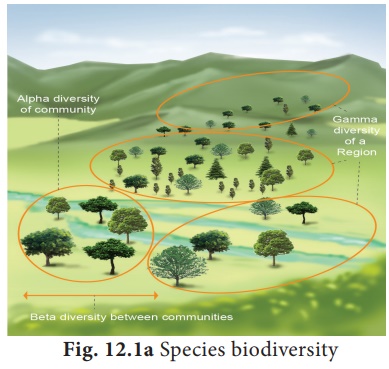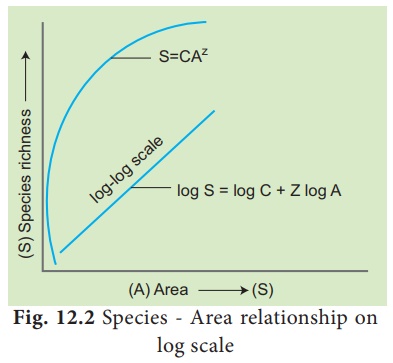Chapter: 12th Zoology : Chapter 12 : Biodiversity and its conservation
Biodiversity
Biodiversity
The 1992 UN Earth Summit defined Biodiversity
as the variability among living organisms from all sources, including
terrestrial, marine and other aquatic ecosystems and the ecological complexes
of which they are a part. This includes diversity within species, between
species and ecosystems of a region. It reflects the number of different
organisms and their relative frequencies in an ecological system and
constitutes the most important functional component of a natural ecosystem.
It helps to maintain ecological processes,
create soil, recycle nutrients, influence climate, degrade waste and control
diseases. It provides an index of health of an ecosystem.The survival of human
race depends on the existence and wellbeing of all life forms (plants and
animals) in the biosphere.
1. Concept of biodiversity
The term biodiversity was introduced by Walter
Rosen (1986). Biodiversity is the assemblage of different life forms. Each
species is adapted to live in its specific environments.
The changes in climatic conditions are reflected
in the distribution and pattern of biodiversity on our planet. The number of
species per unit area declines as we move from tropics towards the poles. The
Tundra and Taiga of northern Canada, Alaska, northern Europe and Russia possess
less than 12 species of trees. The temperate forests of the United states have
20-35 species of trees, while the tropical forests of Panama have over 110
species of trees in a relatively small area.
2. Levels of biodiversity
Edward Wilson popularized the term ‘Biodiversity’ to describe diversity at all levels of biological organization from populations to biomes. There are three levels of biodiversity– Genetic diversity, Species diversity and Community/Ecosystem diversity (Fig. 12.1).
Genetic diversity refers to the
differences in genetic make-up (number and types of genes) between
distinct species and to the genetic variation within a single species; also
covers genetic variation between distinct populations of the same species.
Genetic diversity can be measured using a variety of molecular techniques.
India has more than 50,000 genetic variants of Paddy and 1000 variants of
Mango. Variation of genes of a species increases with diversity in size and
habitat. It results in the
Rouwolfia vomitaria, a medicinal plant growing in different
ranges of the Himalayas shows differences in the potency and concentration of
the active ingredient reserpine due to genetic diversity. Genetic diversity
helps in developing adaptations to changing environmental conditions.

Species diversity refers to the variety in number and richness of the species in any habitat. The number of species per unit area at a specific time is called species richness, which denotes the measure of species diversity. The Western Ghats have greater amphibian species diversity than the Eastern Ghats. The more the number of species in an area the more is the species richness (Fig. 12.1a). The three indices of diversity are - Alpha, Beta and Gamma diversity
i. Alpha diversity: It is measured by counting
the number of taxa (usually species) within a particular area, community or
ecosystem.
ii. Beta diversity: It is species diversity
between two adjacent ecosystems and is obtaining by comparing the number of
species unique to each of the ecosystem.
iii. Gamma diversity refers to the diversity of
the habitats over the total landscape or geographical area.

Community/Ecosystem diversity is the variety of
habitats, biotic communities, and ecological processes in the biosphere. It is
the diversity at ecosystem level due to diversity of niches, trophic levels and
ecological processes like nutrient cycles, food webs, energy flow and several
biotic interactions. India with its alpine meadows, rain forests, mangroves,
coral reefs, grass lands and deserts has one of the greatest ecosystem diversity
on earth.
3. Magnitude of biodiversity
Biodiversity is often quantified as the number
of species in a region at a given time. The current estimate of different
species on earth is around 8-9 million. However, we really don’t know the exact
magnitude of our natural wealth. This is called the ‘The Taxonomic impediment’.
So far about 1.5 million species of microorganisms, animals and plants have
been described. Each year about 10-15 thousand new species are identified and
published worldwide, of which 75% are invertebrates. The number of undescribed
species is undoubtedly much higher.
India is very rich in terms of biological
diversity due to its unique bio-geographical location, diversified climatic
conditions and enormous eco-diversity and geo-diversity. According to world
biogeographic classification, India represents two of the major realms (The
Palearctic and Indo-Malayan) and three biomes (Tropical humid forests, Tropical
Dry/ Deciduous forests and Warm Deserts/Semi deserts). With only about 2.4% of
the world’s total land surface, India is known to have over 8 % of the species
of animals that the world holds and this percentage accounts for about 92,000
known species.
India is the seventh largest country in the
world in terms of area. India has a variety of ecosystems, biomes with its
varied habitats like, hills, valleys, plateaus, sea shores, mangroves,
estuaries, glaciers, grasslands and river basins. It also reflects different
kinds of climates, precipitation, temperature distribution, river flow and soil.
India is one of the 17 mega biodiversity countries of the world and has ten
biogeographic zones with characteristic habitat and biota.
"The world is currently undergoing a very
rapid loss of biodiversity comparable with the great mass extinction events that
have previously occurred only five or six times in the earth's history."
- World Wildlife Fund
4. Patterns of biodiversity distribution
The distribution of plants and animals is not
uniform around the world. Organisms require different sets of conditions for
their optimum metabolism and growth. Within this optimal range (habitat) a
large number and type of organisms are likely to occur, grow and multiply. The
habitat conditions are determined by their latitudes and altitudes.
Latitudinal and altitudinal gradients:
Temperature, precipitation, distance from the
equator (latitudinal gradient), altitude from sea level (altitudinal gradient)
are some of the factors that determine biodiversity distribution patterns. The
most important pattern of biodiversity is latitudinal gradient in diversity.
This means that there is an increasing diversity from the poles to equator.
Diversity increases as one moves towards the temperate zones and reaches the
maximum at the tropics. Thus, tropics harbour more biodiversity than temperate
or polar regions, especially between the latitudes of 23.5⁰N and 23.5⁰S (Tropic of Cancer to
the Tropic of Capricorn). Harsh conditions exist in temperate areas during the
cold seasons while very harsh conditions prevail for most of the year in polar
regions.
Columbia located near the equator (0⁰) has nearly 1400
species of birds while New York at 41⁰N
has 105 species and Greenland at 71⁰N
has 56 species. India, with much of its land area in the tropical latitudes, is
home for more than 1200 species of birds. Thus it is evident that the latitude
increases the species diversity.
Decrease in species diversity occurs as one
ascends a high mountain due to drop in temperature (temperature decreases @ 6.5⁰ C per Km above mean sea
level)
The reasons for the richness of biodiversity in
the Tropics are:
Warm tropical regions between the tropic of
Cancer and Capricorn on either side of equator possess congenial habitats for
living organisms.
·
Environmental conditions of the tropics are favourable not only
for speciation but also for supporting both variety and number of organisms.
·
The temperatures vary between 25⁰C to 35⁰C,
a range in which most metabolic activities of living organisms occur with ease
and efficiency.
·
The average rainfall is often more than 200 mm per year.
·
Climate, seasons, temperature, humidity, photoperiods are more or
less stable and encourage both variety and numbers.
·
Rich resource and nutrient availability.
Mean Sea Level (MSL) is an average level of
the surface of one or more of Earth’s oceans (or seas) from which heights such
as elevations may be measured.

As we travel by train we notice names of
stations on big yellow signboards on which is usually written how much elevated
that place is compared to MSL. For example, Erode junction is about 171 meters
above MSL.
Species - Area relationships
German Naturalist and Geographer Alexander
von Humboldt explored the wilderness of south American jungles and
found that within a region the species richness increased with increasing area
but upto a certain limit. The relationship between species richness and area
for a wide variety of taxa (angiosperm plants, birds, bats, freshwater fishes)
turned out to be the rectangular hyperbola. On a logarithmic scale, the
relationship is a straight line described by the equation.
log S = log C + Z log A
where
S = Species richness
A = Area
Z = Slope of the line (regression coefficient)
C = Y-intercept

Regression coefficient Z generally has a value
of 0.1-0.2 regardless of taxonomic group or region. However, in case of the
species – area relationship in very large areas like entire continents, the
slope of the line appears to be much steeper (Z-value in the range of 0.6-1.2).
For example, in case of the fruit eating (frugivorous) birds and mammals in the
tropical forests of different continents, the slope is found to be a steeper
line of 1.15 (Fig. 12.2)
Related Topics